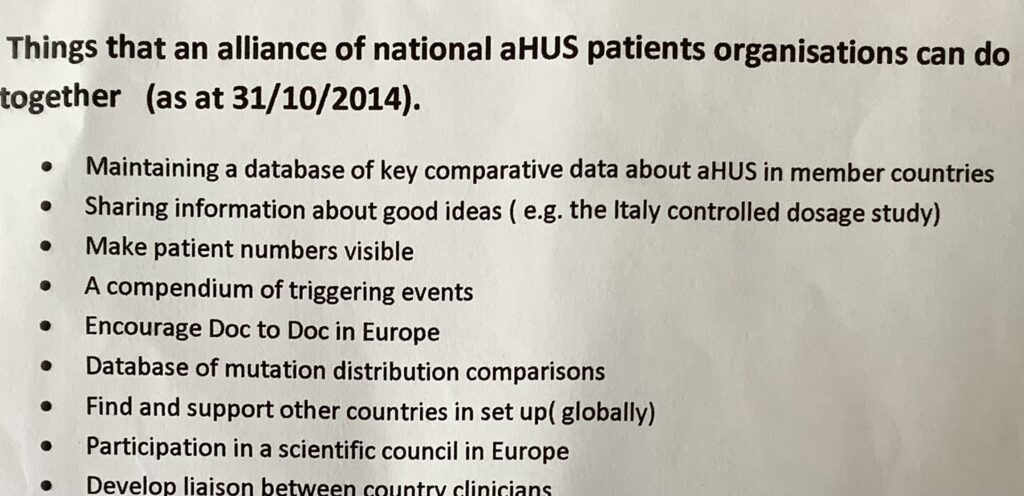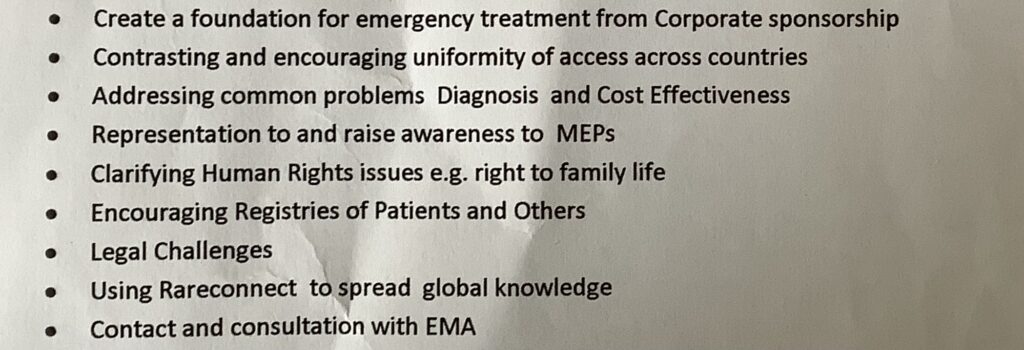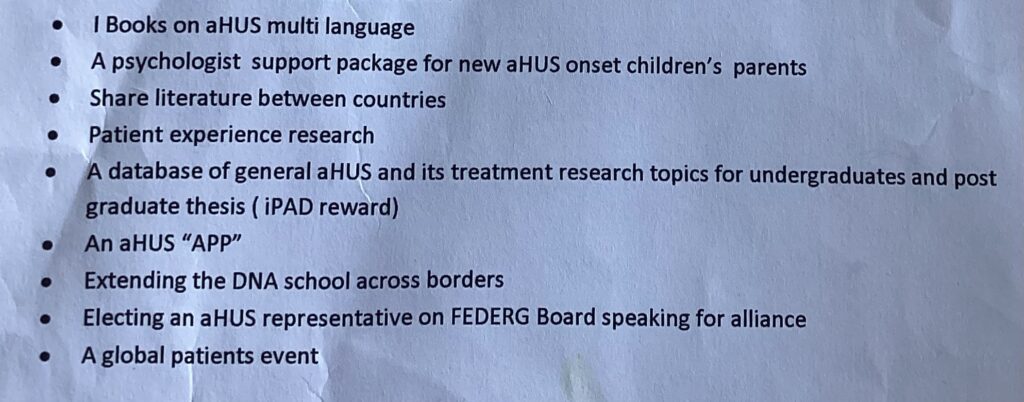You know how when a group forms and they create ideas of what the group can do together – they have aspirations.
Well, the aHUS alliance did just that at its founding meeting in 2013 . Here is a copy of that list which surfaced during a clearance of old files by the author.
What became of those 27 ideas created ?
Here is a detailed summary of what happened to them
Aspirations 1-9

- Maintaining a database of key comparative data about aHIUS in member countries .
A database was begun by affiliates but was incomplete and in time it became unsustainable. Efforts were redirected to collect Global data by country in Polls in 2014 and 2016. It did demonstrate how difficult it to answer how many aHUS patients there are and how do countries differ
2. Sharing information of good ideas ( e.g. the Italy controlled dosage study)
The pioneering work on dosage tapering and withdrawal in Italy was shared and became influential on global patient advocacy to this day. The Netherlands also shared a model for positive health for patients to action plan personal health improvement. France and Spain shared examples of online patient booklets. But it then petered out.
3. Make patient numbers visible
The aHUS alliance was the first provide global patient data in its 2014 Global Poll. The aHUS alliance Global Action has continued to address the sparse data on numbers and challenging the incidence and prevalence of this rare disease e.g. in the USA it is more likely there are 2000 to 3000 aHUS patients than the 600 to 709 often quoted, Any numbers found have illustrated the extreme rareness of aHUS but effective treatments are increasing the number of patients surviving.
4. A compendium of triggering events
Not done.
5. Encourage Doc to Doc in Europe.
A USA idea adopted on aHUS alliance website eventually.
Introduction of a network of ERKNet doctors sharing overtook events in Europe.
6 Database of mutation distribution comparisons
Not done .
7. Find and support other countries in setting up.
Other countries joined the aHUS alliance. aHUS alliance Global Action set up aHUS rest of world organisation which continues today.
8. Participate in scientific council in Europe.
Events over took this with the setting up of ERKNet.
9 Develop liaison between country clinicians.
Not done.
Aspirations 10-18

10. Create a foundation for emergency treatment from Corporate sponsorship.
Explored but not done.
11 Contrasting and encouraging uniformity of access across countries.
Access studied but no uniformity exists.
12. Addressing common problems diagnosis and cost effectiveness.
A major study of the diagnosis process was undertaken and published. Global Action website provided plenty of evidence about the cost effectiveness and affordability topic on its website.
13. Representation to and raise awareness to MEPs
A letter was written to an EU commissioner for health. No reply. Nothing else was done as far as is known.
14. Clarifying human rights issues , right to family life
There is no human right to access a particular medical technology. Decision makers are exempt from action for not approving a drug like eculizumab because it is not affordable or cost effective. It is a right to expect those decisions to be based on proper evidence and done rationally and with no bias nor discrimination. No further action resulted.
15. Encouraging registries of patients and others.
aHUS alliance participated in a Global aHUS Registry from 2015 to 2019. Global Action website has brought attention to other international Registries including ERKNet and the Mario Negri Centre in Bergamo Italy. And USTMA and RaDaR in the USA and UK respectively.
16. Legal challenges
Only done in Russia as far as is known.
17. Using Rareconnect to spread global knowledge.
Initially aHUS alliance did that on EURORDIS’ platform until it created its own website and social media. AHUS alliance Global Action website was the result and is now world renowned for spreading aHUS and complement knowledge to this day. A resource for aHUS patients by aHUS patients. Rareconnect ceased to be an active platform for all rare diseases in December 2023.
18. Contact and consultation with EMA.
Not done but the European Medicines Agency EMA did make contact for input when it began reviewing Ravulizumab for aHUS.
Aspirations 19-27

19 iBooks on aHUS in multi languages.
Work begun with a Spanish version but the project did not progress thereafter . Global Action’s website features articles and information assets in multi languages.
20. A psychologist support package for new aHUS onset children’s parents.
Not done.
21. Share literature amongst countries.
Became a feature when the Global Action website was created and today the database has more than 1300 articles related to aHUS and continues to be updated.
22. Patient experience research
This led to Global Polls in 2014 and 2016 to gather data from aHUS patients about their characteristics and their experience of living with a rare disease.
23. A database of general aHUS and its treatment research topics for undergraduate and post graduate thesis.( iPAD reward)
Not done specifically for junior researchers ( iPAD hardly incentivising) but grew into the Global aHUS Patients Research Agenda which has involved hundreds of people from the aHUS community.
24. An aHUS app.
Thought about but not pursued. Maybe one day.
25 Extending the DNA school across borders
This was a French education resource to learn about DNA and genetics. Nothing further heard about this suggestion.
26. Electing an aHUS representative on FEDERG a European renal genetic patient group.
Someone was elected but eventually FEDERG ceased to be.
27. A global patients event
Not fully defined at the time. A single “in person” meeting or even multi events linked by internet on one day. It did lead eventually to an aHUS awareness Day on the 24 September each yea which began in 2015.
So the aspirations of the forming group were captured then became a matter of what to do about them
The parable of the sower comes to mind.
There were four soils that seeds could fall on and on three of them conditions were such that nothing would grow or flourish. But some fell on good soil.
So it is with the good intentions of a smal group sowing some “ideas” for aHUS over 10 years ago so that “good will come”.
9 out 27 (33%) of their aspirations flourished.
So some good did come as aHUS alliance Global Action is here to testify.
Before the aHUS alliance’s endeavours fade as they must do eventually, the energy in the room that day in Barcelona needs to be acknowledged.
Global or international patient advocacy presents a difficult challenge over a long period of time with no determined finishing date.
Could someone have done better?
Possibly but we will never know.
Article No. 649.

